
Valencia
 Valencia |
SKYLINES AND VIEWS: |
||||
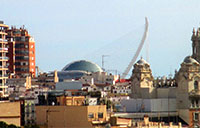 |
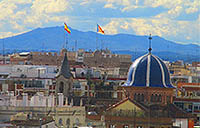 |
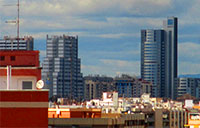 |
||
| Skylines and views | ||||
| CITY CENTER: |
||||
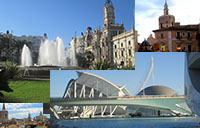 |
 |
 |
||
| Plaza del Ayuntamiento | Plaza de la Reina |
Plaza del Mercat Mercat Central | ||
Plaça de l'Ajuntament, Town Hall Square, Town Hall
|
Catedral de Santa Maria, Plaza Manises, Plaza de San Lorenzo, Plaza Décimo Junio Bruto | Central Market, Placa Redona |
||
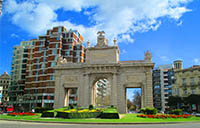 |
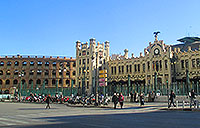 |
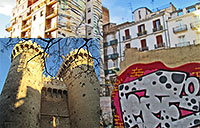 |
||
| The boulevard around the Old Town | Estació del Nord | Barrio del Carmen | ||
Jardines del Turia, Arch of Triumph, Plaza Tetuán, Plaza Alfonso El Magnánimo, Placa de Tetuán, Plaza Temple, Calle Colón, Calle Pinto Lopez, Guillem de Castro, Station |
North Station (Estacion del Norte), Station square |
Torres de Quart |
||
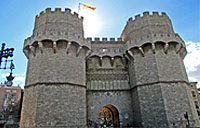 |
 |
|||
| La Lonja de la Seda | Torres de Serranos | |||
La Llotja de la Seda, |
Serrano Towers and views |
|||
|
||||
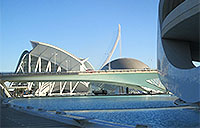 |
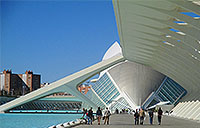 |
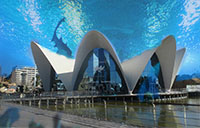 |
||
| Ciutat de les Arts i les Ciències | Príncipe Felipe Science Museum | L'Oceanogràfic Oceanarium | ||
VALENCIA BY NIGHT: |
||||
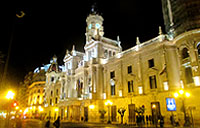 |
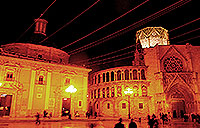 |
 |
||
| City Centre | City Centre | Ciutat de les Arts i les Ciències | ||
OUTSKIRTS: |
||||
 |
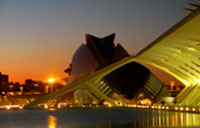 |
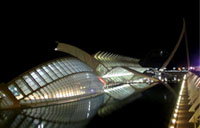 |
||
| Valencia Airport, Metro and Outskirts |
Population: 809 000 (metro 1 705 000) |
Valencia is Spain's 3rd largest city, and the largest city of Valencia autonomous community. It is a very beautiful city, boasting both a historical city center with grandiose buildings and the ultra futuristic City of Arts and Sciences (Ciutat de les Arts i les Ciències), with some of the most futuristic buildings in the world. Valencia was founded 138 BC as a Roman colony. It is situated on Spain's East coast, fronting the Gulf of Valencia at the river banks of Turia. After severe floodings in 1957, the flood was transformed into an enormous, narrow park called Jardines de Turia (Turia Gardens), bordering the old town. Even though the city centre is situated inland, the Mediterraenan coast is just East of the city. There are several beaches in the Eastern outskirts and the Port of Valencia is the busiest container port on the Mediterranean Sea, and the 5th busiest in Europe. The traditional Spanish dish of paella was born in Valencia, and at many restaurants Valencian paella is severd. It is also home to the annual Falles festival, where handmade monuments are burnt in honour to Saint Joseph. The city center is very old, and very compact despite it is one of the largest in Spain (169 ha). You can easily walk around the historical buildings in the Old Town, that makes Valencia's one of Spain's most popular tourist attracions. The most famous historical building is Valencia Cathedral (Catedral de Santa Maria), a gothic cathedral right in the heart of Valencia. It is situated between the major squares Plaza de la Reina and Plaza Virgen, where you find fountains, cafés, restaurants, palms, trees and beautiful historical buildings. All over the old town you find beautiful churches, interesting stores and open air restaurants. In the North end of the Old Town, you will find Torres de Serranos, facing Turia Gardens. This is an ancient gateway of the city wall, and can for a small fee be climbed to offer great views of Valencia. Torres de Quart is another city gate, situated in the West part of the Old Town. La Lonja de la Seda, the former Silk Market, is a historic gothic building that is very popular to visit because of it's large proportions and cathedral like architecture from 1548. In the North part of the city centre, you find Barrio del Carmen. This is a district that has become popular with hipsters, artists, punks and other alternative people. Here you find walls with graffiti, hip cafés, alternative stores and galleries. Plaza del Ayuntamiento (Town Hall Square) is the heart of Valencia. Triangular in shape and very large, this is one of the most beautiful squares in Europe, and here you find some of Spain's most beautiful buildings, like the Town Hall, the Post Office, as well as a splendid fountain, hotels, cafés, restaurants, kiosks, benches, palms, trees and heavy traffic. Plaça de l'Ajuntament (Valencian spelling) is close to the main station in the city center, Estació del Nord (Northern Station), that is a very beautiful art nouvau building. Just next to it stands Plaza del Toros, a bullfighting arena (yes it's still allowed in parts of Spain!) with an architecture that reminds of Colosseum, and a matador statue. Mercado Central (Central Market) is situated just North of Plaza del Ayuntamiento, in the Old Town. It is sitauted at Plaza del Mercado, and is a very impressive indoor market hall with lots of foods, fruits and souvenirs, and other stuff are sold outside. The surrounding neighbourhood is very pleasant with small colourful houses, cafés and open air restaurants. One heavily trafficated boulevard around the old town in a loop. Part of it follows the Turia Gardens with it's gardens beneath street level. The road changes names several times. It starts to the East of the Northern Station as Calle Colón, goes in a loop around the Old Town and ends to the West of the station with the name Guillem de Castro, then changes name to Xàtiva. Along this road you find Torres de Serranos, Torres de Quart, the Arch of Triumph, Plaza Tetuán, Plaza Alfonso El Magnánimo, Plaza Temple, Palace of Justice, museums and several baroque churches. Valencia has great art museums; Museu de Belles Arts de València for traditional art, and Institut Valencià d'Art Modern for modern art. Ciutat de les Arts i les Ciències (City of Arts and Sciences), is an entertainment-based cultural and architectural complex that was developed in the late 1990s and 2000s, situated East of the city centre. The futuristic buildings are designed by the world famous Valencian architect Santiago Calatrava and Félix Candela. It is as important to visit as the historical city centre. Here you find a futuristic atmosphere with exciting white buildings in imanative shapes, blue water pounds, and sculptures, all centered around 8 structures: El Museu de les Ciències Príncipe Felipe, an interactive science museum with impressive architecture that resembles the skeleton of a whale and covers 40,000 m², L'Hemisfèric, a curvy IMAX theatre that was one of the first of the futuristic buildings built on the site (1998), El Palau de les Arts Reina Sofía, a huge opera house designed by Calatrava, is the world's tallest opera, and has an extremely interesting oval shape, it opened in 2005, is 80m tall and 230m long, L'Oceanogràfic that is Europe's largest oceanographic aquarium and was built in the shape of water lilies, L'Àgora, the latest and tallest building (86m), a blue shell shaped building for concerts, exhibitions and sporting events inaugurated in 2009, L'Umbracle, a tropical garden and El Pont de l'Assut de l'Or, a very cool 125m high suspension bridge that is the tallest structure in Valencia. Torres de València is a skyscraper project proposed for the City of Arts and Sciences, consisting of 3 twisted glass skyscrapers 266, 220 and 308m tall. They are designed by Santiago Calatrava and resemble Malmö's Turing Torso. However, since the financial crisis in 2009, the possibility that these towers will get built is very low. But never say never... In the East and West outskirts there are some modern shiny office buildings, but not exactly tall enough to be skyscrapers, the lowest doesn't even reach the height of the lowest one of the proposals mentioned above. The two tallest buildings in Valencia have 35 floors each - Melia Hotel (former Hilton) and Torre de Francia). There are also about 22 buildings with 20-22 floors, most of them built in the 2000s. In the outskirts you will find the 106m tall communication tower Torre Telefonica. The outskirts are filled with modernist apartment buildings, 8-12 stories tall, filled with services as supermarkets, restaurants, cafés etc. The nearer the city center you reach, the more old and beautiful buildings you will find. Valencia has a good, modern metro system, though not very extensive. You can easily use the good bus system with it's red buses, where you can pay with coins. In the outskirts there are also lighrail trams. Public transport is only necessary though, if you are going outside the city center, otherwise it is easier to walk on foot, along the square and pedestrian streets. It is not recommended to drive in central Valencia, we drove through it when leaving the car, traffic can be pretty intense, drivers impatient and there are often six lanes in each direction! MY EXPERIENCE: We visited Valencia as the grande finale after a trip to Costa Blanca, Murcia and Valencia. We stayed in Valencia for two full days and two half days. We arrived by a rental car, a Ford Focus that we left at Valencia Airport. Last day we took train back to Alicante from Estacio del Nord (Northern Station) because our flight was departing from Alicante Airport. During our visit Spain hit somewhat of a cold period, even for February when we visited. Some parts even had snow during our visit, but not Valencia. It was colder then usual though. But it was still very sunny most of the time and was a great pleasure to visit as a Scandinavian arriving from real winter. It was 12-15 degrees during our visit, making the Valencianos walking around freezing in thick jackets and scarfses, meanwhile we were enjoying the sunny "spring weather" and walked without jackets! We were even warned by the hotel to go outside without thick clothes because of the "coldness"! We visited the Valencia Cathedral and La Lonja de Seda, but no art museums. We also climbed Torres de Serrano, went inside the beautiful Town Hall and it's museum and visited some other churches. We also walked ot Mercato Central (the Central Market) and visited the hip neighbourhood Barrio del Carmen. There was simply too much to see in the city. We spent one day at City of Arts and Sciences, where we admired the architecture, visited the Principe Felipe science museum and saw an IMAX movie about butterflies at L'Hemisfèric. The day after, we spent half the day at L'Oceanogràfic, Europe's largest aquarium. The complex offers some of the most breathtaking architecture I have seen in my entire life. Food was very good in Valencia, we tried paella and sangria several times. There are really many nice cafés in Valencia, Café y Tapas is a good chain. Even wintertime you can often sit outside, at least daytime, if you don't hit a cold period. We walked a lot around the pedestrian streets and plazas of the Old Town, and only had to use public transport twice (metro from car rental at the airport and bus to City of Arts and Sciences). Overall we liked Valencia very much, it is actually one of the top five cities in the whole Europe! Architecturally, it is definately hard to beat Valencia! We stayed at the 4 star Ayre Hotel Astoria Palace right in the heart of Valencia, only a few blocks from the Town Hall Square. It was a very good hotel. Read reviews in this section. During the trip we also visited various cities and places in the Alicante regione of Costa Blanca , and Murcia. |